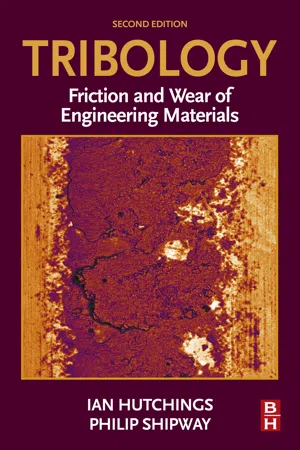
- 412 pages
- English
- ePUB (mobile friendly)
- Available on iOS & Android
About this book
Tribology: Friction and Wear of Engineering Materials, Second Edition covers the fundamentals of tribology and the tribological response of all classes of materials, including metals, ceramics, and polymers.This fully updated and expanded book maintains its core emphasis on friction and wear of materials, but now also has a strengthened coverage of the more traditional tribological topics of contact mechanics and lubrication. It provides a solid scientific foundation that will allow readers to formulate appropriate solutions when faced with practical problems, as well as to design, perform and interpret meaningful tribological tests in the laboratory. Topics include the fundamentals of surface topography and contact mechanics, friction, lubrication, and wear (including tribo-corrosion), as well as surface engineering, selection of materials and design aspects.The book includes case studies on bearings, automotive tribology, manufacturing processes, medical engineering and magnetic data storage that illustrate some of the modern engineering applications in which tribological principles play vital roles. Each chapter is complemented by a set of questions suitable for self-study as well as classroom use. This book provides valuable material for advanced undergraduates and postgraduates studying mechanical engineering, materials science and other technical disciplines, and will also be a useful first reference point for any engineer or scientist who encounters tribological issues.- Provides an excellent general introduction to friction, wear, and lubrication of materials- Acts as the ideal entry point to the research literature in tribology- Provides the tribological principles to underpin the design process- Through systematic coverage of the subject and appropriate questions, develops the reader's understanding and knowledge of tribology in a logical progression.
Frequently asked questions
- Essential is ideal for learners and professionals who enjoy exploring a wide range of subjects. Access the Essential Library with 800,000+ trusted titles and best-sellers across business, personal growth, and the humanities. Includes unlimited reading time and Standard Read Aloud voice.
- Complete: Perfect for advanced learners and researchers needing full, unrestricted access. Unlock 1.4M+ books across hundreds of subjects, including academic and specialized titles. The Complete Plan also includes advanced features like Premium Read Aloud and Research Assistant.
Please note we cannot support devices running on iOS 13 and Android 7 or earlier. Learn more about using the app.
Information
Introduction
Abstract
Keywords
| Savings in maintenance and replacement costs | 45% |
| Savings in losses resulting from breakdowns | 22% |
| Savings in investment through increased life of plant | 20% |
| Reduction in energy consumption through lower friction | 5% |
| Savings in investment through greater availability and higher efficiency | 4% |
| Reduction in manpower | 2% |
| Savings in lubricant costs | 2% |
| Direct savings of energy | |
| Primary: | saving of energy dissipated by friction |
| Secondary: | saving of energy needed to fabricate replacement parts |
| Tertiary: | saving of energy content of materials for replacement parts |
| Indirect savings of energy | |
| Savings consequential on direct savings, e.g., in plant needed to compensate for frictional losses | |
Table of contents
- Cover image
- Title page
- Table of Contents
- Copyright
- Preface to the second edition
- Preface to the first edition
- 1: Introduction
- 2: Surface topography and surfaces in contact
- 3: Friction
- 4: Lubricants and lubrication
- 5: Sliding wear
- 6: Wear by hard particles
- 7: Surface engineering
- 8: Design and selection of materials for tribological applications
- 9: Applications and case studies
- Appendix A: Indentation hardness—Measurement and meaning
- Appendix B: Fundamentals of corrosion and tribocorrosion
- Appendix C: Definition of wear rate
- Author Index
- Subject Index
